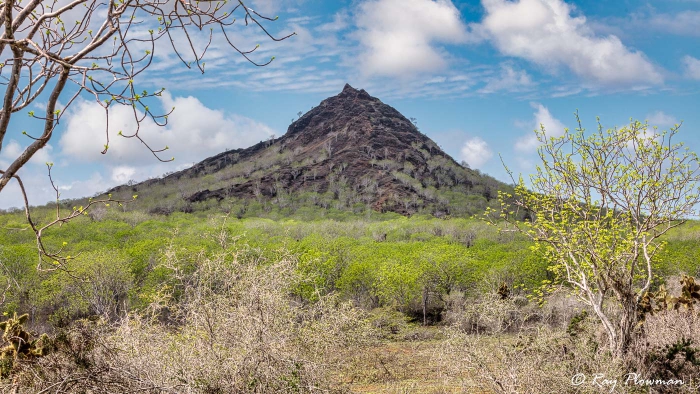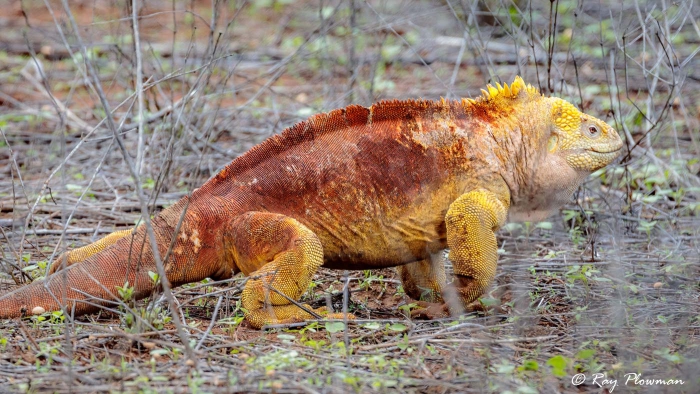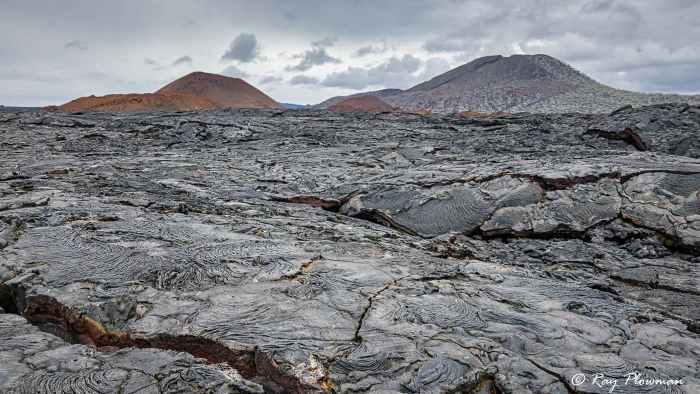Dragon Hill and Sullivan Bay
Day thirteen sites we visited were Santa Cruz’s Dragon Hill and Sullivan Bay on Santiago.
Dragon Hill
Dragon Hill on Santa Cruz is home to a colony of reintroduced land iguanas (Ref 1 and Ref 2). The site also has a rocky shore and two saltwater lagoons which attract waders (shorebirds). Santiago’s Sullivan Bay visitor site has a barren landscape almost devoid of all flora and fauna. The main attraction is the flat pahoehoe lava and pyroclastic tuff cones (Ref 3).
We cruised from Floreana to Santa Cruz’s north coast, anchoring at Dragon Hill (Cerro Dragon). It was our third visit to Santa Cruz Island, the fourth if I include South Plaza. It was a dry landing on some rocks at the beach, then a walk to the land iguana colony.

Dragon Hill and Palo Santo Trees
Dragon Hill (Cerro Dragón) is an eroded tuff volcano surrounded by Palo Santo trees and Opuntia cacti forest. It is also home to a breeding land iguana colony.

Galapagos Land Iguana feeding at Dragon Hill
The Galápagos Land Iguana (Conolophus subcristatus) is one of three land Iguanas in the Galápagos, the other two are the Santa Fé and pink land iguanas. Furthermore, this species also found on Isabela, Fernandina, and nearby Santa Cruz islands of Plazas, Baltra and North Seymore.
Wildlife at Dragon Hill
[foogallery id=”17285″]
Dragon Hill Wildlife
We went ashore after breakfast to walk about one kilometre to the land iguana colony. Along the trail, I photographed a wading least sandpiper at the first saltwater lagoon. The path passed through a wooded area of Palo Santo trees. Featured wildlife in the woods was a male Santa Cruz lava lizard and a female yellow warbler. After leaving the woods, the trail looped around a large area where I photographed the Galápagos land iguanas. Also, Galápagos mockingbirds, a Dragon Hill landscape, and a Galápagos flycatcher. Finally, returning through the Palo Santo Forest photographed a pair of common cactus finches. And near the beach a Galápagos marine iguana endemic to Santa Cruz (subspecies hassi).
Sullivan Bay
We got underway at lunchtime for our voyage to Sullivan Bay on Santiago Island. Also, our third visit to Santiago, having visited Sombrero Chino on day two, Puerto Egas and Bartolomé on day seven. Before going ashore at Sullivan Bay, it was time for a panga ride to Bartolomé’s southern beach.
Green Turtles at Bartolome’s South Beach
[foogallery id=”17287″]
Green Turtles at Bartolome’s South Beach
Although we have had been on a panga ride to Bartolomé’s north and east coast, we had not visited the south beach. It was a miserable cloudy day, and the sea was quite choppy. But it was worth it to photograph turtles nesting on the beach and mating in the sea. Reverse size dimorphism of endangered green turtles is evident in the two photos, males being half the size of females. The final image shows plastic pollution affecting even the remote Galápagos Islands.
After the panga ride, it was time to get our feet wet, landing on Bahia Sullivan for a walk through the lava fields.

Sullivan Bay Lava Fields
Sullivan Bay is a barren landscape comprising flat pahoehoe lava with pyroclastic tuff cones. The older ones are reddish.
Santiago’s Lava Landscapes at Sullivan Bay
[foogallery id=”17286″]
Lava Landscapes at Sullivan Bay
After the voyage from Dragon Hill on Santa Cruz Island, we anchored at Sullivan Bay. Mid-afternoon, we landed on the rocks at the beach. It is a circular walk across the pahoehoe lava. Although the landscape seems desolate, Mollugo plants grow in crevasses as they colonize the barren terrain. Landscape photos from the beach feature Bartolome and Pinnacle Rock on the other side of the bay.
References and Bibliography – Online Resources
1. Iguanas and Lizards 2021. [Online] Available from Galapagos Conservancy [Accessed 18-Sep-21].
2. Galapagos iguanas transferred due to overpopulation 2021. [Online] Available from PHYS ORG [Accessed 9-Oct-21].
4. Galapagos Geology on the Web – Santiago 2021. [Online] Available from Available from Galapagos Geology on the Web [Accessed 22-Sep-21].
3. Global Volcanism Program – Santago 2013. [Online] Available from Smithsonian Institution National Museum of Natural History [Accessed 18-Sep-21].